Tenerife or Fuerteventura: which island is the best?
Here's how these Canary Islands stack up!So you’ve decided that your next adventure is in the Canaries, but one (or two) questions remain: Tenerife or Fuerteventura? Fuerteventura or Tenerife? Which island is actually the best one?
On the surface, it might seem like an easy choice, but the closer you look at what the islands have to offer, the harder it gets to decide. Are you all about long stretches of golden sand, or do you crave adventure on volcanic peaks? Do you prefer lively towns with buzzing nightlife, or a slower pace with endless horizons?
To make life easier (and to save you time for planning the fun stuff), we’ve compared both islands side by side. From beaches and nature to culture, family holidays, and even camping, here’s everything you need to know to decide if Tenerife or Fuerteventura is the right island for you.
- Beaches
- Nature & outdoors
- Food & culture
- Nightlife & entertainment
- Family holidays
- Camping
- Weather
- Best time to visit
- How to get there
- So, how do the islands compare?
Fuerteventura vs Tenerife on the beaches
If it’s one thing that Tenerife does best, it is variety and there is no better example than its coastline. In the south, you’ll find some of the island’s most famous golden-sand beaches, such as Playa de las Américas, Los Cristianos, and Playa del Duque. These are lively stretches with calm waters, sunbeds, and plenty of restaurants, appealing to families and those who like their beach days with a bit of buzz.
Head further north, and the scenery totally changes: think dramatic volcanic sands at Playa Jardín in Puerto de la Cruz or the rugged Playa de Benijo, surrounded by steep cliffs and the Atlantic waves. You'll also find some of the best surf spots in the Canaries on this side of the island. Tenerife’s beaches are well-equipped, with lifeguards, facilities, and easy access, making them a safe bet if convenience is key.
If your heart desires keeping things simple and you like having your space, then Fuerteventura is the one for you. With more than 150 km of sandy coastline and many of its vast beaches having an untouched feel, you are bound to find your very own stretch of sand. The Corralejo Dunes are among its most iconic landscapes, offering endless golden sands against turquoise waters. Other highlights include the epic isolation of Playa de Cofete, the fun of Popcorn Beach, and the wind- and kitesurfing mecca of Sotavento. Unlike Tenerife, beaches here are rarely crowded, giving Fuerteventura a wilder, freer atmosphere.
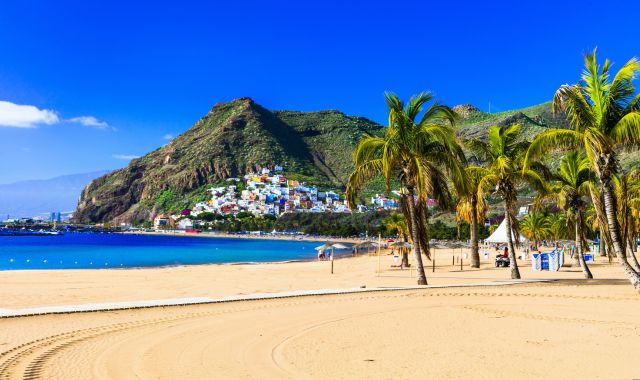
Las Teresitas is just a short hop from Santa Cruz de Tenerife
Nature & outdoors in Fuerteventura and Tenerife
When it comes to landscapes, Tenerife is the heavyweight of the Canary Islands. At its heart stands Mount Teide, Spain’s highest peak, and its UNESCO-listed national park. Hiking trails here range from relaxed walks through lava fields to the challenging climb to the summit, which you can also ascend in a cable car for breathtaking views.
In the north, the landscape is greener, with the Anaga Rural Park standing out for its deep ravines, laurel forests, and panoramic coastal views. Add in the dramatic cliffs of Los Gigantes and whale- and dolphin-watching opportunities off Tenerife’s coast, and you’ve got a destination packed with outdoor variety.
Fuerteventura is wilder and more stripped back, with landscapes shaped by wind and sand. The island is famous for its desert-like interior and unique volcanic cones, such as Calderón Hondo, which you can hike for sweeping views of the island. The Corralejo Natural Park is a major highlight, with rolling dunes that spill into turquoise waters.
On the southern coast lies the Jandía Peninsula, with rugged mountains, remote beaches, and protected wildlife reserves. While Tenerife dazzles with contrasts, Fuerteventura’s raw simplicity makes it perfect for solitude, wide horizons, and space to breathe.
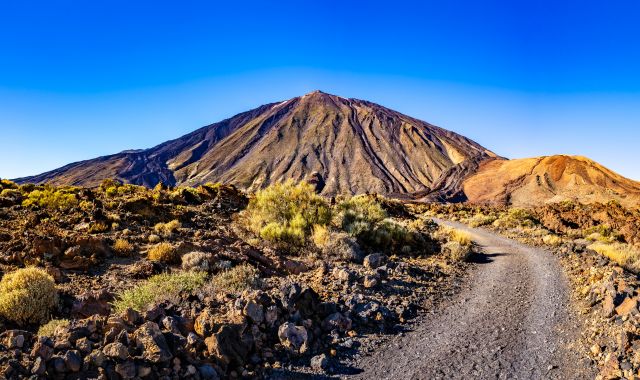
All roads in Tenerife lead to Mount Teide!
Food & culture of Tenerife and Fuerteventura
Tenerife is the cultural hub of the Canary Islands, blending lively modern cities with deep traditions. The capital, Santa Cruz de Tenerife, is a cosmopolitan city full of museums and theaters, with the Santa Cruz de Tenerife Carnival being a riot of costumes, music, and parades each February that rivals Rio. Just inland, San Cristóbal de La Laguna is a UNESCO World Heritage Site, with colonial architecture, pastel-colored houses, and cobbled streets that make it a must for history lovers.
On the culinary side, Tenerife boasts a broad range of dining options, with everything from fine restaurants to traditional guachinches (family-run taverns), where you can taste some of the most delicious food in the Canaries. Tenerife staples include papas arrugadas with mojo sauce, grilled meats, and fresh seafood, all of which are paired with wines from the island’s volcanic vineyards.
Conversely, Fuerteventura has a quieter and more rustic feel, with the island culture rooted in small villages and local traditions. Wander through the whitewashed houses and centuries-old church in the former capital of the island, Betancuria, for a taste of its storied history. Across the island, fishing villages like El Cotillo and Morro Jable serve up some of the freshest seafood in the Canaries.
Fuerteventura’s gastronomic pride is queso majorero, a goat’s cheese so distinctive it carries a protected designation of origin. Festivals tend to be more low-key, but retain their authenticity and urgency, celebrating rural life, folklore, and island identity.
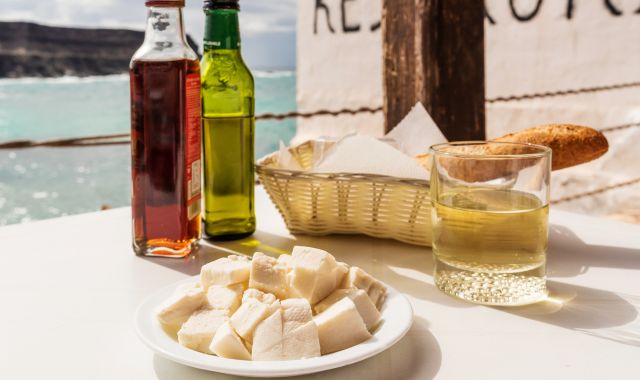
Foodies are in for quite the treat!
Nightlife in Fuerteventura and Tenerife
If you’re looking for lively evenings, Tenerife is the clear frontrunner, with the nightlife in the south being legendary. Playa de las Américas and Costa Adeje are hotspots for bars, clubs with international DJs, and beachfront lounges where the music goes on until dawn. In the north, the vibe is more low-key, with stylish wine bars in La Laguna or live music venues in Santa Cruz offering a more local flavor.
Beyond nightlife, Tenerife also offers a wide choice of evening entertainment, from sunset cruises to tapas tours. The variety means you can go from sipping cocktails by the beach to catching live music in the same night.
Fuerteventura, in contrast, is much quieter after sunset. The main hub is Corralejo, where you’ll find a handful of pubs, relaxed beach bars, and small venues with live music. Evenings here are more about cocktails by the sea and laid-back vibes than high-energy parties. In the island’s smaller towns and villages, nightlife is almost non-existent, adding to Fuerteventura’s charm for travelers who prefer calm nights under the stars.
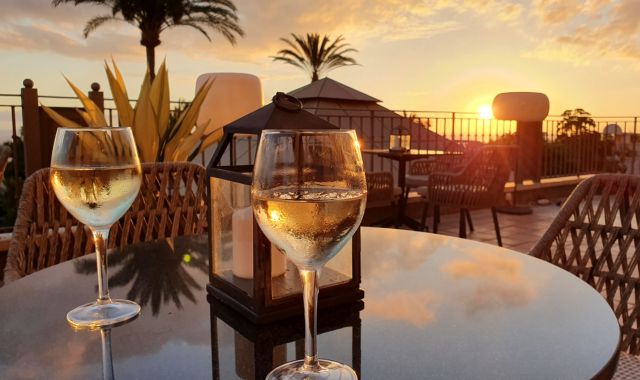
Enjoy the sunset in Tenerife with a glass of local wine
Tenerife and Fuerteventura family holidays
Tenerife is one of the best all-round choices for families in the Canaries. Siam Park, often ranked as the world’s top water park, has everything from splash zones to adrenaline slides that will thrill and entertain children (and adults) of ages. Loro Parque in Puerto de la Cruz is another family favorite, combining dolphins, penguins, and fun shows with an educational twist. Beaches like Playa de las Teresitas and Playa de las Vistas, with calm waters and lifeguards, make days by the sea simple and safe.
Fuerteventura, while less flashy, has its own strong appeal for families. The island’s main draw is its endless sandy beaches, where children can play and explore freely without the crowds you will find on busier islands. Families staying in Corralejo often take a day trip to Los Lobos, a small island just offshore, perfect for short hikes and beach picnics. Add in dolphin-spotting boat tours, the Oasis Wildlife Park, or sandcastle-building marathons in the Corralejo Dunes, and there’s plenty to keep everyone entertained.
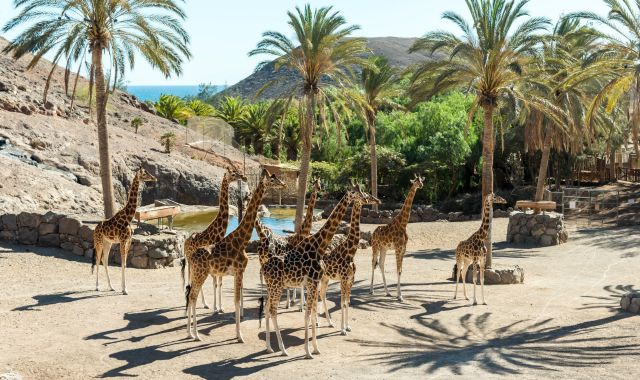
Giraffes at the Oasis Wildlife Park in Fuerteventura
Camping options in Tenerife and Fuerteventura
If you’re looking for a more adventurous way to experience the Canaries, both Tenerife and Fuerteventura have options for camping under the stars, though the experience is quite different on each island. Camping is only allowed in designated areas with a permit, which you can easily arrange in advance.
In Tenerife, campsites are mostly found in natural parks and forests, making them perfect if you like combining hiking with outdoor living. Laguna Grande in the Anaga Rural Park and Aguamansa in La Orotava valley are two local favorites, surrounded by shady pine forests and mountain trails. For something truly special, you can camp near Teide National Park and spend your evenings stargazing in one of Europe’s best dark-sky reserves. Facilities are usually simple but you can usually count on basics, like water, toilets, and showers.
In Fuerteventura, camping tends to be coastal, with sites spread across the island. In Antigua, you’ll find quiet seaside camping at Pozo Negro, while Pájara in the south is perfect if you want beaches on your doorstep. El Cotillo (La Oliva) is a favorite with surfers and families, and there are more options near Puerto del Rosario, Betancuria, and Tuineje. Facilities tend to be simpler, but the trade-off is waking up to ocean views or volcanic landscapes.
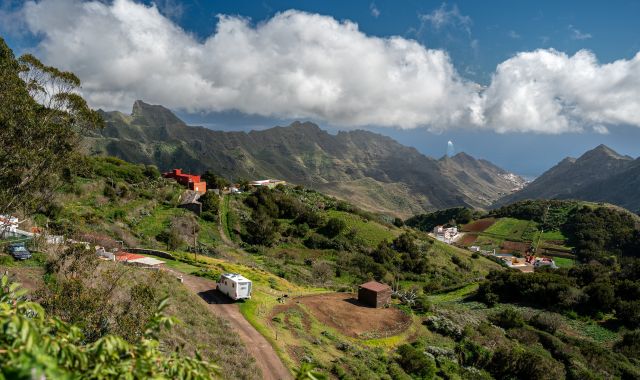
Bring your motorhome and discover the "unfiltered side" of Tenerife
FAQs
Is Tenerife hotter than Fuerteventura?
Not quite, both islands enjoy the warm, sunny weather that is typical of the climate in the Canary Islands, but there are some subtle differences to consider. Fuerteventura is drier and sunnier throughout the year, with little rainfall and extended periods of hot and windy days. Generally, the weather in Fuerteventura is consistent across the island.
Tenerife, on the other hand, has a greater variation of climates. The southern side of the island tends to be hot and dry, similar to Fuerteventura, while the north is cooler and more humid. During winter, it can get chilly in higher altitudes, with Mount Teide often being snow-capped.
When is the best time to visit the Canaries?
The beauty of the Canary Islands is that they don't really have an off season. With average temperatures hovering between 20-28°C and plenty of sunshine year-round, you can pick almost any month and still find good weather. So while there is there no real best month to visit the Canaries, there are a few things to keep in mind.
Summer (June to September) is the classic beach season, with hot and dry weather that is perfect for long days by the sea. It’s also the busiest time, with Tenerife and Fuerteventura’s beaches packed with sunseekers.
If you’d rather avoid the high season crowds and sense of being rushed, then consider heading over during spring (April-May) or autumn (October-November). The weather is still warm and the sea is inviting. Without the summer crowds, it's easier to enjoy Tenerife’s hiking trails or Fuerteventura’s dunes.
Even in winter (December to March), the islands don’t lose their charm. While Mount Teide in Tenerife often wears a snowy cap, the southern beaches stay warm enough for sunbathing. Fuerteventura, with its dry climate and wide open coastlines, is one of Europe’s most reliable winter-sun escapes.
How do I get to Tenerife and Fuerteventura?
Getting to the Canaries can be part of the adventure itself. Flying is the fastest option, but taking ferry to the Canaries from mainland Spain lets you slow down, soak up the sea views, and ease into holiday mode. It’s also practical, since you can bring your car, motorbike, or even a camper van, giving you the freedom to explore Tenerife or Fuerteventura on your own terms and venture well beyond the usual tourist spots.
From mainland Spain, the Cádiz - Tenerife ferry operates 1-2 times a week, all year round, while the trip lasts around 27 hours. You can also travel by ferry from Huelva to Tenerife, with about 2-5 weekly crossings and a typical travel time of 32 hours. Similarly, the Cádiz - Fuerteventura ferry connection is served once a week and takes around 37 hours.
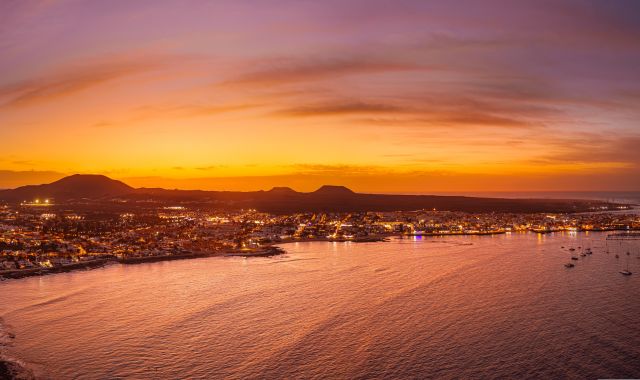
Golden hour in Corralejo, Fuerteventura
So, how do Tenerife and Fuerteventura compare?
To help you decide faster, here’s do a quick recap of how Tenerife and Fuerteventura compare across the essentials..
- Beaches: in Tenerife you can switch between golden sands and volcanic coves in a single day, while Fuerteventura is all about wide, open beaches that seem endless.
- Nature & outdoors: Tenerife dazzles with contrasts, from volcanic peaks to green forests, while Fuerteventura strips it back to dunes, desert views, and raw coastline.
- Food & culture: Tenerife serves up city life, carnivals, and vineyard dining, whereas Fuerteventura keeps things grounded with fishing villages, local cheese, and rustic traditions.
- Nightlife: nights in Tenerife pulse with energy with clubs, bars, and live music, while Fuerteventura keeps it low-key with cocktails by the sea and quiet evenings.
- Family holidays: Tenerife is built for kids, with waterparks, zoos, and family resorts, while Fuerteventura wins on space, safe beaches, and a slower pace.
- Camping: in Tenerife campsites are nestled in forests and mountain valleys, while Fuerteventura gives you coastal spots right by the sea.
Still torn between Tenerife and Fuerteventura? How about visiting both of these Canary Islands then? Ferries travel every day between Tenerife and Fuerteventura and the journey takes as little as 4.5 hours. The trip involves a stop in Gran Canaria, so that's a three-island adventure in a single trip!
After all, island-hopping in the Canaries is simple, affordable, and the best way to see more of what this sunny archipelago has to offer. Check our Map of ferries to visualize your trip, see all available routes and book ferry tickets in just a few clicks!